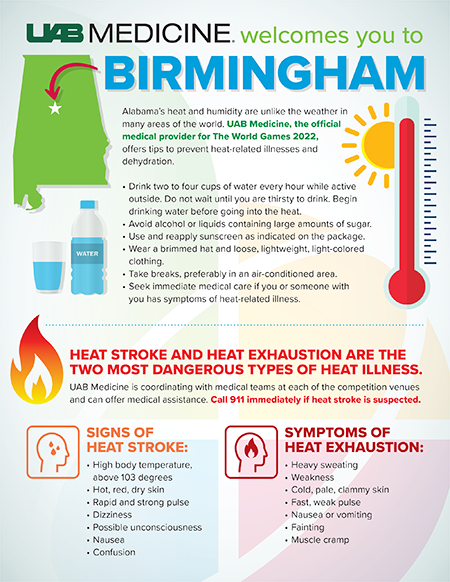
Click graphic to enlarge.Summer months are made for spending time outdoors. But the extreme heat can lead to health concerns if one does not take care of themselves, especially at The World Games. University of Alabama at Birmingham experts provide tips on how to stay safe and well when attending the major sporting events coming to our area. UAB Medicine is the official medical provider for the games. UAB health professionals are coordinating medical teams to care for athletes and spectators at each of the 14 venues where competition will take place.
Hot enough? Tips for dealing with the heat
Alabama in July can be hot and humid. Medical providers say to stay hydrated, keep cool and be aware of the signs of heat illness.
“The body uses sweating to cool itself; but with extreme temperatures, high humidity and a high heat index, body temperature can rise to dangerous levels,” said Marie-Carmelle Elie, M.D., chair of the Department of Emergency Medicine in the UAB Marnix E. Heersink School of Medicine. “Older adults, young children and those with preexisting conditions are at highest risk; but anyone can develop heat-related illnesses under the right conditions.”
Signs of heat stroke include:
- High body temperature, above 103 degrees
- Hot, red, dry skin
- Rapid and strong pulse
- Dizziness
- Possible unconsciousness
- Nausea
- Confusion
Symptoms of heat exhaustion are:
Learn more about UAB and The World Games here.
- Heavy sweating
- Weakness
- Cold, pale, clammy skin
- Fast, weak pulse
- Nausea or vomiting
- Fainting
- Muscle cramp
“Heat stroke and heat exhaustion are the two most dangerous conditions,” Elie said. “Heat stroke is a medical emergency — call 911 immediately if heat stroke is suspected. For heat exhaustion, reduce the person’s body temperature with cool cloths or even a bath, but do not give fluids.”
Hydrate often
Drinking enough fluids is one of the most important things one can do to prevent heat-related illness. According to Ksenia Blinnikova, M.D., an assistant professor in the UAB Department of Family and Community Medicine, it is important for those planning to stay in the heat for an extended period of time to carry a bottle of water with them everywhere they go. She also says limiting the consumption of caffeinated drinks, including coffee, tea and sodas, is important.
“An easy rule of thumb is to drink 1 milliliter of fluids for every calorie consumed,” Blinnikova said. “In other words, if you eat 2,000 calories per day, then you should drink 2,000 milliliters of fluids per day, which equals 68 ounces. To help you determine the exact amount you should be drinking a day, I recommend talking with your primary care provider.”
For those who do not enjoy drinking plain water, Blinnikova says drinking flavored water, water with flavoring additives and sparkling water is also a way to stay hydrated. Overall, it is important to stay away from caffeinated beverages and beverages with added sugar to help prevent becoming dehydrated.
Say no to sunburns, yes to sunscreen
While spending time outside has positive health benefits, the sun can be a short- and long-term enemy. One in five Americans will develop skin cancer, according to estimates by the American Academy of Dermatology. Avoiding ultraviolet light — a risk factor for all types of skin cancer — could prevent more than 3 million skin cancer cases annually.
When attending The World Games, it will not always be easy to avoid these harmful rays, which is why using sunscreen is important. Lauren Kole, M.D., assistant professor in the UAB Department of Dermatology, shares her best practices for sunscreen use.
- Buy sunscreens that are 30 SPF or higher. No sunscreen can block 100 percent of the UV rays, but 30 SPF blocks around 97 percent. Look for a water-resistant formula to combat sweating.
- Benefits differ for the four basic forms of sunscreen — spray, cream, gel or stick.
- Sprays are easy to apply, but people rarely apply enough, applying only around 25-50 percent of the recommended amount needed. They are also harder to apply around the face.
- Creams take longer to apply but can be applied to almost everywhere on one’s body, including the face. People tend to rub in and apply creams slightly more.
- Sticks are not realistic to use for one’s entire body but are perfect for safely applying sunscreen to the face, including the lips.
- Gels are the most effective around hairy areas. For people who are not wearing a hat, gel sunscreen is a good option to protect the scalp.
- Apply sunscreen at least 15 minutes before going outside to allow the sunscreen to fully absorb into the skin and form its protective barrier. Reapply every two hours, after swimming or excessive sweating.
- After sun exposure, take cool baths to reduce the heat, applying moisturizers and drinking plenty of water to prevent dehydration. Hydrocortisone cream may be applied to sunburns to ease discomfort.
 “In addition to sunscreen, other sun-protection best practices include wearing coverings, such as hats and sunglasses, and being extra diligent about applying sunscreen when in direct sunlight between 10 a.m. and 4 p.m.,” Kole said. “Sunscreens help protect against both UVA rays, which cause premature aging in the skin, and UVB rays, which cause sunburn. Exposure to both UVA and UVB may lead to skin cancers in the future.”
“In addition to sunscreen, other sun-protection best practices include wearing coverings, such as hats and sunglasses, and being extra diligent about applying sunscreen when in direct sunlight between 10 a.m. and 4 p.m.,” Kole said. “Sunscreens help protect against both UVA rays, which cause premature aging in the skin, and UVB rays, which cause sunburn. Exposure to both UVA and UVB may lead to skin cancers in the future.”
Protect your eyes from the sun and heat
According to a review article published in the Eye & Contact Lens journal, UV light exposure from UVA and UVB rays can cause cumulative damage to the eye, which can result in solar crystalline lens — also known as cataracts, corneal and conjunctival lens damage. Exposure to a significant amount of sunlight may also increase risk of macular degeneration.
To avoid possible eye damage due to harmful UV rays while attending outdoor events for The World Games, a combination of multiple protective measures should be adopted to protect the eyes. Katherine Weise, O.D., pediatric optometry service director at UAB Eye Care, advises wearing polarized sunglasses that provide 100 percent UV protection. Weise wants to remind spectators that UV protection contact lenses are also available and says they may even be better since they directly cover the front of the eye. A wide-brimmed hat is also helpful.
“UV rays can come from many different directions, so it is important to take a combination of measures to protect yourself from the sun,” Weise said. “To reduce the risk of eye damage from the sun’s harmful rays, kids and adults should wear sunglasses whenever they spend daytime outdoors. We see UV protection for the eyes as important as sunscreen.”